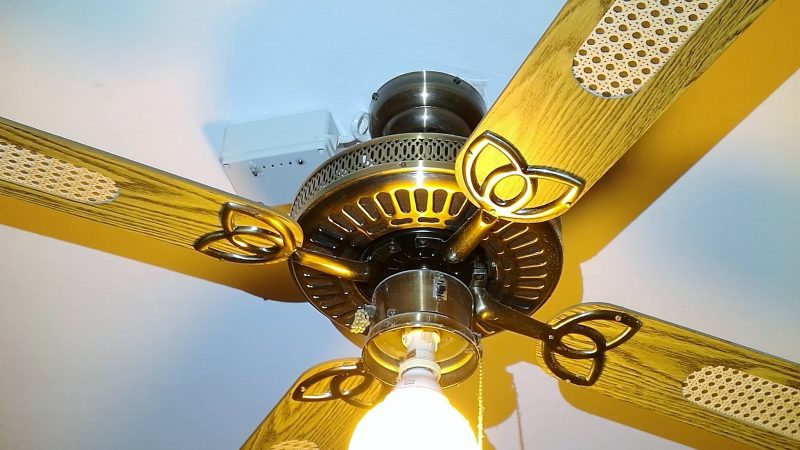Putting everything on the Internet is getting easier and easier, what with the profusion of Internet-ready appliances as well as cheap and plentiful IoT modules to integrate legacy devices. Think IoT light bulbs, refrigerators and dishwashers that can be controlled from a smartphone, and the ubiquitous Sonoff modules. But once these things are on the net, what are they talking about? Are they saying things behind your back? Are they shipping data about your fridge contents off to some foreign land, to be monetized against your will?
Maybe, maybe not, but short of a tinfoil helmet the only way to protect yourself is to build your own system. This IoT control for ceiling fans is a good example, with the added benefit that most wireless ceiling fan remotes are kind of lousy. [microentropie] didn’t like the idea of going the Sonoff route, so his custom controller is based on that IoT workhorse, the ESP8266. There are two versions, one switching the light and fan loads with relays, and one with triacs. The ESP serves up its own web page for control rather than using a cloud service, and is capable of setting up the fan to turn on and off automatically at preset times or temperatures. Everything sits in an unobtrusive box on the ceiling near the fan, but we bet this could be miniaturized enough to fit right inside the fan housing.
If some of [microentropie]’s code looks familiar, it might be because he borrowed it from his IoT rice cooker project.















Having the ability to control the speed and direction might be nice. Also on the fan perhaps instead of the timer or along with it, the ability for it to click off when it reaches it’s temperature set point and back on when it goes over it.
Because it’s been my personal bugaboo for the past month, I’d be tempted to add a real 2-phase motor controller to it to get arbitrary speeds.
Ceiling fans seem to generally be permanent-split-capacitor single-phase induction motors.
Of course, there’s a lot safety-wise to be said for NOT working with high voltage power electronics…
Completely o/t but here is my favorite current IoT nonsense.
https://www.charbroil.com/smartchef
Thanks gregkennedy,
LoL the awkwardness of turning steaks with one hand whilst watching/navigating the phone’s user interface (UI) with the other would have my peers in stitches :-) Then to counter that would be a Google Glass type headset with head movements accessing the UI or if I really went to town, left/right foot up/down for left/right mouse clicks. Then I could have both hands free but, what a sight to behold !
I love the pic in the picture of the guy with the phone in one hand and the tongs on the BBQ in the other. It doesn’t look like a happy smile to me. It’s imagination time! It’s more like “Why are you judging me? Yea I’m using my phone to BBQ. So what if humans were doing it for hundreds of thousands of years without Apple? You want to fight about it? I’m ready to go right now! LETS GO” and the guy in the background is laughing at the absurdity, or he knows something like the woman he wants to fight is a 5th degree black-belt in karate and would crush him.
On a less ominus side, having Bluetooth in a BBQ is like the bluetooth on my Anova. It’s virtually useless and contributes nothing since there’s no temperature profiles and less convenient than a kitchen timer since your phone needs to basically be in bluetooth range the entire time. Not to mention if you have a phone “OK Google, set a 2 hour timer for sous vide steaks”. As for the wireless checking of the probe, you can get wifi and bluetooth smoker/bbq probes for $30 on amazon and use with whatever BBQ you want, anywhere you want making it more versatile.
You do realize that whatever you do, there is at least one layer beyond any controls in esp?
Please excuse, my tinfoil squeeze on forehead is bit strong today.
All this makes me wish I’d done more documenting on my LOT (LAN of things) which never, ever does anything with the internet. The dox I did do aren’t Hackaday grade and a full rev behind what I now have on my off-grid homestead. In the latest rev, a single Pi handles all the slaves, is an AP itself (slaves have a private LAN of their own), runs a DB and plotting software as well as a web server my “main” LAN can see to control various homestead functions via CGIs. The previous rev used pairs consisting of a pi and an uno (because pi’s kinda stink at doing sensors and simple but hardcore realtime stuff), and was all on my LAN, providing somewhat more attack surface, not that it matters out in the boonies that much…who is going to mess with my water collection/purification system or my power system and so on? I was more interested in having it independent of outside services I had no control over – imagine having some provider tell you your homestead isn’t going to work anymore..as it is, my LOT is a set of addresses the telco router can’t even see, at least for all but the front-end pi.
A little here:
http://www.coultersmithing.com/forums/viewforum.php?f=59&sid=57d823c684ae21fad352ea0f1e4631b1
Wait, I thought Sonoff modules _were_ ESP8266, with a ready-to-go relay and enclosure?
They are, I’m not sure what the point was there. You can flash your own firmware as well